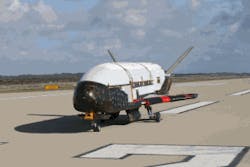Embraer, Garmin improve Phenom 300 pilot situational awareness with synthetic vision
By John McHaleSAO JOSE DOS CAMPOS, Brazil 13 Jan. 2011. Responding to increased demand from pilots and operators, officials at Embraer and Garmin have brought synthetic vision technology to the cockpits of the Phenom 300 executive jet family. The aircraft is the first in the light jet category to offer synthetic vision."The highlight especially for the Phenom 300 is that we are able to introduce synthetic vision in the light jet segment," which was struggling in terms of new offerings, says Carlos Fernandez, head of product strategies for synthetic vision at Embraer. Embraer plans to migrate the synthetic vision system to other business jet families such as the Legacy 500 and 650 and eventually all executive jets will probably have it, Fernandez says."We chose Garmin from the start," as they introduced synthetic vision as an affordable technology, Fernandez continues. Embraer can provide this situational awareness enhancement at about $25,000 to $30,000, he adds.The Garmin synthetic vision technology (SVT) has received the Brazilian National Civil Aviation Agency (Agencia Nacional de Aviacao Civil – ANAC), the U.S. Federal Aviation Administration (FAA), and the European Aviation Safety Agency (EASA) certifications. The SVT recreates a visual topographic landscape from the system's terrain-alerting database via sophisticated graphics modeling, which simulates what the pilot would see with the naked eye in broad daylight. It is particularly helpful in fog, rain, haze, darkness, or instrument flight conditions, Embraer officials say. It has a pilot interface primary flight display (PFD) with a 3-D, color-coded depiction of surroundings including large water bodies, runways, and other obstacles where flight-into-terrain risks exist in the flight path, Fernandez says. The system also provides Traffic Information Service (TIS) alerts from the database with 3-D traffic with traffic collision avoidance system (TCAS)-like symbology, he continues. Trouble spots are marked with amber or red overlays.
On the PFD and multi-function display (MFD) there is a lateral field of view capability to bring a more enhanced situational awareness with a top view at while at a 45 degree angle of flying, Fernandez says."Basically we worked together with Garmin to create all system's colors and to harmonize the system with Embraer's cockpit philosophy" and represented it to pilots to nail down human factors requirements, Fernandez says.Today Embraer is only offering synthetic vision systems and not enhanced visions systems, which provide a fused image of synthetic data and real-life imagery, Fernandez says. The technology is still about five to seven years away before it is fully certified and deployed in large numbers, he adds.Operators can upgrade to the Garmin synthetic vision system via software, says Margaret Kako, Phenom avionics supervisor. It is a simple upgrade for the Phenom avionics platform as that is provided by Garmin as well, she adds.The Phenom jets use the Garmin Prodigy flight deck, which has an integrated Prodigy avionics suite. Flight deck features include enhanced situational awareness, glass cockpit with large displays, new avionics, and single pilot operation.

